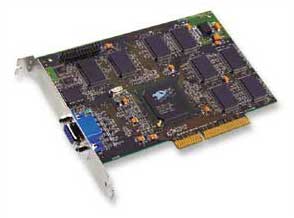Voodoo Banshee

Why the first, after all, there was already Voodoo Rush, combining 2D and 3D solutions? The matter is that Voodoo Rush consisted of two chips - separately for 2D graphics (manufactured by Alliance ProMotion) and separately for 3D graphics. In the case of Banshee, the situation is slightly different. Banshee is a single chip that integrates a 128-bit 2D core and a 3D core based on Voodoo2 technology.
Since this step is the first for 3dfx in the development of full-fledged 2D/3D chips.
Features of 3dfx Voodoo Banshee
| type |
2D/3D |
| Technology | 0.35 Micron |
| Throughput |
4 mPolys/sec |
| Fillrate | 100 mPix./sec |
| API | DirectX 6.0/OpenGL MCD/Glide |
| RAMDAC | 250 |
| Memory vol. | Up to 16 Mb |
| memory type | SDRAM/SGRAM |
| Z-Buffer | 16-bit |
| Max 3D resolution | 1600x1200 |
As you can see, the 2D part of Banshee has a fairly powerful 128-bit 2D engine. Thanks to the correct architecture of the 2D core, Banshee competes in 2D output speed with such video chips as Rage128, RivaTNT, G200. In terms of quality, the 250MHz RAMDAC provides good quality at high resolutions. What Banshee doesn't have are DVD functions like Fourier transforms, and so on. Because of this, Banshee is not recommended for watching videos. But the conclusion can be drawn as follows: the first pancake did not turn out to be lumpy. And the 2D core is well done.
Let's move on to 3D. It would be more correct to say that the truncated Voodoo2 is used as 3D. Why truncated, yes, because Banshee uses only one TMU module, instead of two on Voodoo2. Therefore, there is no multitexturing on Banshee. But we can't say that Banshee is a high-quality 2D core plus half of Voodoo2. Let's take a look at Banshee's improvements over Voodoo2. Support for up to 16 megabytes of memory allows you to make available 3D resolutions up to 1900x1200. Support for SDRAM / SGRAM type memory allows you to get a wider video memory bandwidth and increase the speed. 250 MHz RAMDAC improves the picture compared to Voodoo2 at the same resolutions and makes it possible to use higher screen refresh rates.
The operation of the core at a frequency of 100MHz and the ability to "overclock" up to 120 MHz. Because of this, Banshee was able to process up to 3 million polygons per second. Memory operation at a frequency of 100MHz. Fillrate in non-multitexturing mode - from 100 MPixels/Sec. Video cards based on Voodoo Banshee could be made in both PCI and AGP designs.



